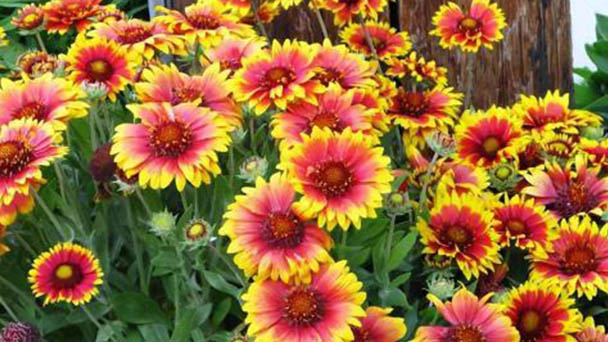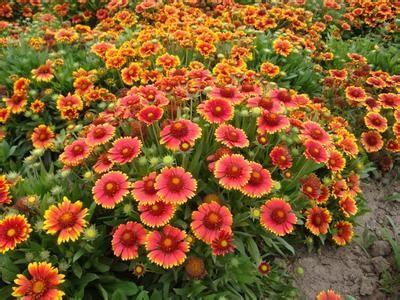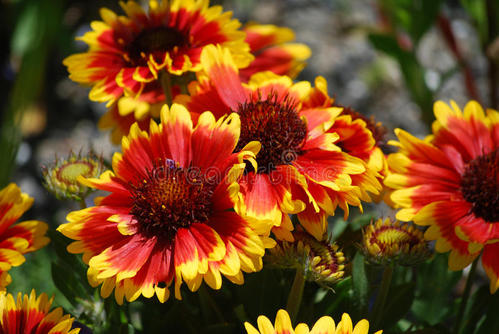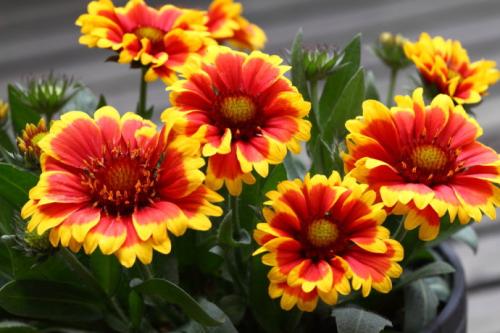Gaillardia Pulchella (Indian blanket) profile
Written by Maggie
Feb 26 2021

Gaillardia pulchella Foug, commonly called Indian blanket, is native to North America, widely cultivated in central and southern China. Indian blanket is the state flower of Oklahoma and Penghu County in Taiwan.
Indian blanket picture

Morphological features of Indian blanket
Indian blanket is an annual herb. Plant height is about 20 ~ 60cm, whole plant pilose. Leaves are alternate, lanceolate, moment round to spatulate, entire margin or base leaf pinnacles. Valvular, ligulate flower apex yellow, base brownish purple. Flowering period of Indian blanket is in summer and autumn.
Cultivated varieties Indian blanket, Tongue flowers and inflorescences pot heart shaped flowers are developed into a funnel, there are large flowers and safflower varieties.
Indian Blanket's flowers are called "heads." "A flower" is actually a "bouquet" because it contains many tongue and tube flowers. The outer tongue flowers are colourful, like an airfield attracting insects; In the middle of the tubular flowers grow like small balls, when the tongue flowers wither, this part of the fruit group will develop, the seeds inside the wind and then fall to the ground to grow. And some of the Indian blanket's tongue-like flowers will grow into tube-shaped, curved-looking trumpets. Some varieties of Indian blanket the whole flower is bright yellow, unique charm; The leaves and pubescence of Indian blanket are also worth looking at.
Ecological habits of Indian Blanket
Indian blanket likes hot, dry and sunny environments. Indian blanket has good salt resistance, strong wind resistance, drought resistance, cold resistance and slightly poor negative resistance.
Indian blanket is native to North America, resistant to drought and heat, not cold, like sunshine, also resistant to half shade, suitable for loose soil with good drainage. Indian blanket is wind - resistant, moisture - resistant, natural toughness, with drought - resistant characteristics is a good windproof sand plant. If in acid soil, it is not only difficult to obtain strong seedlings, the leaves withered in midsummer, rapid growth fertilizer should be applied early, the ratio of phosphorus and potassium needs to be higher.
Indian Blanket propagation methods
Seed propagation
Often in the summer for sowing, sowing with the substrate for disinfection, the best way is to put it into the pot to heat up, which can be hot to death. Soak the seeds of Indian blanket in warm water (about the same temperature as your face wash) for 3 to 10 hours, until the seeds absorb water and swell. For very common seeds that germinate easily, this job can be left out. For small seeds that are difficult to clip up by hand or other tools, one end of the toothpick can be wet with water, stick the seeds one by one on the surface of the substrate, cover the substrate 1 cm thick, and then put the seeding pot into the water, the depth of the water is 1/2 ~ 2/3 of the height of the pot, and let the water slowly soak up. For larger seeds of Indian blanket that can be held by hand or with other tools, place the seeds directly into the substrate and seed them at 3 x 3 cm intervals .After sowing, the substrate is covered with 2 ~ 3 times the thickness of seed grains. After sowing available sprayer, fine pore sprinkle sowing matrix quality wet, when the basin soil is slightly dry and then drenched, still should pay attention to the strength of watering can not be too big, so as not to flush up the seeds;Management after sowing: after planting seedlings unearthed, to uncover the film in time, and every day before 9:30 in the morning, or after 3:30 in the afternoon to let the seedlings receive the sunlight, otherwise seedlings will grow very weak; After most of the seeds of Indian blanket have come out, it is necessary to thin the seedlings properly: diseased, unhealthy seedlings are pulled out, so that the remaining seedlings have a certain space between each other;When most seedlings have three or more leaves, you can pot them.
Cutting propagation
The branches used for cuttings are called cuttings. Usually combined with heart work, pick down the sturdy, no pests and diseases of the top as cuttings, directly with the top cuttings. Cuttings should pay attention to the following management: temperature: the optimal rooting temperature of cuttings is 18℃ ~ 25℃, lower than 18℃, cuttings rooting difficult and slow; If the temperature is higher than 25℃, cuttings are susceptible to pathogen infection and rot, and the higher the temperature is, the greater the proportion of rot. Cutting after low temperature, insulation measures are mainly used to use the film to cuttage pot or container wrapped up; Cuttings after the temperature is too high temperature, cooling measures are mainly to shade cuttings, to cover 50 ~ 80% of the sun, at the same time, to spray cuttings, 3 ~ 5 times a day, the number of sunny day higher spray is more, rainy day temperature lower temperature is larger, the number of spray is less or not spray.

How to grow and care for Indian Blanket
Moisture care
Indian blanket likes higher air humidity, air humidity is too low, will accelerate the single flower wither.Also afraid of rain, need to keep the leaves dry at night. The optimum air relative humidity is 65 ~ 75%.
Temperature care
Indian blanket is heat resistant, not frost resistant.
Light care
Indian blanket likes full sunshine, slightly tolerant of half shade.
Water care
The Indian blanket, like other plants, requires a lot of fertilizer and water, but it must follow the principle of "frequent application of light fertilizer, frequent application of small amounts of fertilizer and complete nutrition". After fertilization, it must keep its leaves and flowers dry at night.
Summer, autumn: it is the peak season of growth, fertilizer and water management in accordance with the order of "huabao" -- "huabao" -- "huabao" -- water cycle (at least two times a week to ensure "huabao"). After entering the flowering period, proper control of fertilizer to facilitate seed maturity.
The Indian blanket's distribution area
Native to the central United States, the Indian blanket is a short-growing annual plant that has been artificially introduced and cultivated.
Indian blanket is distributed in North America, tropical America and the American continent.
Garden use of Indian blanket
Indian blanket is a very good sand greening, beautification, sand fixing herbs. Its flower appearance is enchanting, the color is gorgeous, the flowering period is long, the cultivation management is simple, can be used as the flower bed, the flower cluster material.
Tending management: loam or sandy loam is the best soil for Indian blanket cultivation. Drainage, sunshine should be good, if the sunshine is insufficient, the flowering is not good, fertilizing once a month. The suitable temperature for growth is 10-25 ℃.
Indian blanket flower language
The Indian blanket's flower language and symbolic meaning: unity, unity and cooperation.

Latest Updated
- Benefits of Bugleweed - 7 Science-backed Health Benefits
- Bugleweed Dangers & Side Effects - Is It Poisonous?
- How to Plant Evergreen Trees - What You Should Know
- When to Plant Evergreens - Grow Guide for Evergreen Trees
- 12 Wonderful Evergreen Shrubs for Your Garden
- 12 Popular Evergreen Plants with Pictures for Beginners
- When And How To Prune A Lilac Bush Like a Pro
- How to Grow & Care for Lilac Vine (Hardenbergia Violacea)
- Japanese Lilac Tree (Syringa Reticulata) Care & Propagation Guide
- Shumard Oak Pros and Cons - What to Know
Popular Articles
- Winter maintenance of Antirrhinum Majus
- How to Grow Terminalia Mantaly Tree
- How to Grow and Care for Crossostephium Chinense
- How to grow Antirrhinum Majus in spring
- Peristeria Elata (Dove Orchid) Profile: Info & Care Guide
- Underwatered Snake Plant (Sansevieria Trifasciata) - Signs And How To Fix
- How to Care for Brazilian Jasmine Plant (Mandevilla Sanderi)
- How to Grow & Care for Graptopetalum Purple Delight in Summer
- Rosa Chinensis (China Rose): Plant Growing & Care Tips
- How to Care for Baby Sun Rose (Aptenia Cordifolia)